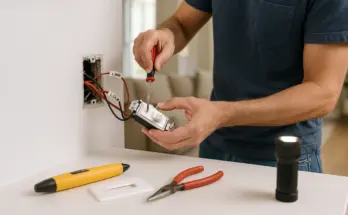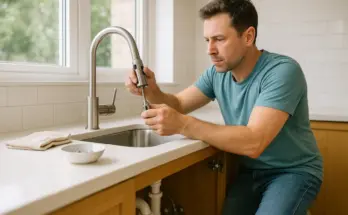Ever wondered if there’s a better way to deal with clogs than dumping harsh cleaners down the drain? We’ve all faced slow sinks or backed-up showers, and it’s easy to reach for a quick fix. But there’s a smarter option—we can unclog drains without chemicals and avoid the risks that come with them. Chemical cleaners may seem convenient, but they can damage our pipes, pollute the environment, and release harmful fumes. Instead, let’s choose safer, simpler methods that actually work and protect our home in the process.
Plus, when we handle the problem ourselves, we save money. No expensive plumber visits, no toxic fumes, and no second-guessing. Just quick, clean results.
We’ll walk you through the best tool-based solutions that are safe for your home and friendly to the planet. So grab your plunger or that old wire hanger, and let’s fix that drain—naturally.
Why You Should Unclog Drains Without Chemicals
When we choose to unclog drains without chemicals, we’re doing more than just fixing a clog—we’re protecting our home and health. Chemical cleaners might seem convenient, but they often come with hidden risks. For starters, many of these products contain harsh ingredients that can pollute our water systems. Once they’re washed down the drain, they don’t just disappear—they can harm aquatic life and the environment.
In addition, these chemicals can eat away at older or PVC pipes. Over time, that damage may lead to costly repairs. Why risk breaking down our plumbing when there’s a better way?
Let’s not forget the fumes. Even a quick pour can release strong vapors that irritate our lungs, eyes, or skin. Especially in small bathrooms or kitchens, it’s not something we want to breathe in.
Thankfully, we don’t need to rely on harsh chemicals. Instead, we can use simple, affordable tools that are safe for our homes and the environment. They’re reusable, too—so we can tackle future clogs without buying more products. By making this switch, we take control of the problem while keeping things safer and greener. It’s a small change that makes a big difference.
Tools You’ll Need
To unclog drains without chemicals, we don’t need anything fancy—just a few basic tools we can find almost anywhere. A plunger is always a great first step. If that doesn’t work, we can try a manual or drill-powered drain snake for deeper clogs. For hair and gunk near the surface, a Zip-It tool or plastic drain cleaner works wonders.
Sometimes, a wet/dry vacuum can pull a clog right out. If we’re in a pinch, even a wire coat hanger can help break things up. And while this guide focuses on tools, baking soda and vinegar offer a natural boost we can use with them.
Most of these tools cost less than $25 and are easy to find at hardware stores or online. Better yet, we can use them again and again. With just a small investment, we’ll be ready to handle clogs safely and confidently—without harsh chemicals.
Step-by-Step: How to Unclog a Drain With a Plunger
When we want to unclog drains without chemicals, a plunger is often our first and best tool. It works great on sinks, tubs, and even some shower drains. If water is draining slowly or sitting still, it’s a good time to reach for the plunger.
Proper Plunging Technique
First, we need to cover the drain completely with the plunger cup. If it’s a sink, plug the overflow hole with a wet rag. For double sinks, seal the second drain the same way. This helps create better suction.
Next, fill the sink or tub with enough water to cover the plunger. Then, push down and pull up in steady, firm motions. It’s not about strength—it’s about rhythm and pressure.
Tips to Get a Strong Seal
To improve suction, we can run hot water for a few seconds before plunging. This softens grease or soap scum. Also, adding petroleum jelly to the rim of the plunger can help seal the edges.
What to Do if It Doesn’t Work
If the clog doesn’t move after a minute or two, don’t panic. We can try repositioning the plunger or switching to another tool. Sometimes, alternating between tools helps break things loose.
Plunging may not be glamorous, but it’s simple, safe, and surprisingly effective. With the right technique, we can unclog drains without chemicals and skip that expensive plumber visit.
Using a Drain Snake or Auger
If plunging didn’t do the trick, it might be time for a drain snake. We use it for stubborn clogs deeper in the pipe. It works well in bathroom sinks, tubs, and kitchen drains—especially when the blockage is out of reach.
How to Insert and Operate It
First, we gently push the snake into the drain until we feel resistance. That’s likely the clog. Then, we turn the handle to break through or hook the clog. Once we feel it give way, we slowly pull the snake back out. Be ready for a bit of mess—it means we’re making progress!
Manual vs. Powered Snakes
Manual snakes are great for most household jobs and are easy to control. Powered snakes (drill-attached or electric) are faster and work well for tougher clogs. However, they require more care. For light DIY jobs, we usually stick with manual.
Safety Tips and What to Avoid
Always wear gloves to keep things clean and safe. Also, don’t force the snake—this can damage the pipe. If we feel too much resistance, it’s best to pull back and try again.
Snaking takes patience, but it’s a powerful way to unclog drains without chemicals. It gets deep into the line, removes the clog, and saves us from calling in a plumber. With a little practice, this tool becomes a go-to for serious clogs—no chemicals needed.
Try a Zip-It Tool or Plastic Drain Cleaner
When we need to unclog drains without chemicals, a Zip-It tool or plastic drain cleaner is a simple go-to. These flexible, barbed tools are great for pulling out hair and soap scum from bathroom sinks, tubs, and showers. They’re especially handy for clogs just below the surface.
To use one, we just insert it slowly into the drain. Then, we pull it out with a quick motion. The barbs grab onto hair and debris, clearing the way. It might be gross—but it’s also super satisfying to see that clog come out.
We can use this tool as often as we like, but once a month is a good routine. Regular use helps keep buildup from turning into bigger problems.
Unlike chemical cleaners, this method won’t damage pipes or release harmful fumes. Plus, there’s no waiting or guessing. We see results immediately. And because it’s reusable or recyclable, it’s better for the environment too.
With just a few seconds of effort, we can unclog drains without chemicals and keep things flowing smoothly. It’s quick, safe, and perfect for everyday clogs.
Wet/Dry Vacuum Method
When we want to unclog drains without chemicals and nothing else has worked, a wet/dry vacuum might do the trick. It’s especially helpful for tough sink clogs or when plungers and snakes aren’t enough.
To start, we switch the vacuum to “wet” mode. Then, we cover the drain tightly with the hose nozzle. We can use a wet rag or towel around the hose to help create a strong seal. The tighter the seal, the better the suction.
Before turning it on, we make sure the vacuum is empty and ready for water. This helps avoid overflow or mess. Also, we keep a towel nearby—just in case things get a little splashy.
Once we turn on the vacuum, we might hear a sudden rush. That’s a good sign. It means the clog is breaking free. If it works, water should drain quickly once the suction stops.
This method doesn’t work every time, but it’s worth trying before calling a plumber. Plus, it’s another smart way to unclog drains without chemicals and avoid pipe damage. It may take a few tries, but when it works, it’s fast and satisfying.
DIY Wire Hanger Trick
When we need to unclog drains without chemicals and don’t have tools on hand, a wire hanger can help. It’s a quick, last-minute option for shallow clogs—especially hair or debris just inside the drain.
First, we grab a standard wire hanger and straighten it out as much as possible. Then, we bend one end into a small hook. This helps us grab onto gunk inside the pipe.
Next, we carefully insert the hook into the drain. We twist and pull gently to catch hair or buildup. It’s important not to force it, since too much pressure could damage the pipe or scratch the surface.
This trick works best for bathroom sinks and tubs with accessible clogs. It won’t reach deep blockages, but it’s great in a pinch. While it’s not a long-term solution, it’s a clever way to unclog drains without chemicals when we’re short on options.
Prevent Future Clogs Naturally
Once we unclog drains without chemicals, it’s smart to keep them that way. Prevention saves us time, effort, and future headaches. One easy fix is installing drain screens. These catch hair, food, and debris before they enter the pipes.
We should also flush drains with hot water once a week. This helps clear grease and buildup. For extra care, we can pour a mix of baking soda and vinegar down the drain monthly. Let it fizz for a few minutes, then rinse with hot water.
In bathrooms, hair catchers are a must. They’re cheap, easy to clean, and very effective. And every now and then, it helps to inspect drains for slow flow or odd smells. Catching small issues early prevents bigger ones later.
With a few simple habits, we can avoid clogs entirely. Better yet, we’ll keep our pipes clear and continue to unclog drains without chemicals—the safe, smart way.
When to Call a Plumber
Sometimes, even when we try to unclog drains without chemicals, the problem goes deeper than we can reach. If water backs up in multiple drains, smells like sewage, or gurgles constantly, it’s time to call a plumber. These signs point to serious issues like blockages in the main line. While we love DIY, some jobs are best left to pros. Acting early can prevent water damage and bigger repair bills. So, if nothing works or things get worse, don’t wait. A quick call now can save us time, stress, and money in the long run.
Final Thoughts on Unclog Drains Without Chemicals
When we unclog drains without chemicals, we protect our health, the planet, and our pipes. Simple tools get the job done safely and cheaply. Plus, we skip the mess and cost of calling a plumber. With just a little effort, we can fix most clogs ourselves. So let’s try the DIY route first—it’s easier than we think! If you found this guide helpful, bookmark it for later or share it with a friend. Every clean drain starts with one small step!
Frequently Asked Questions (FAQ) Unclog Drains Without Chemicals
1. What’s the easiest way to unclog a drain without chemicals? A plunger is usually the easiest tool to start with. It’s simple, effective, and works great for sinks and tubs.
2. Can baking soda and vinegar really unclog drains? They can help with light buildup or as part of regular maintenance. For tough clogs, though, we’ll need a tool.
3. Is it safe to use a drain snake on all types of pipes? Yes, if we’re gentle. Manual snakes are safe for most home pipes. Just don’t force it if it feels stuck.
4. How often should I clean my drains to prevent clogs? Flushing with hot water weekly and using baking soda and vinegar monthly can keep drains flowing smoothly.
5. When should I stop trying and call a plumber? If multiple drains back up, smell bad, or gurgle, it’s time to call in a pro. It may be a deeper issue.



